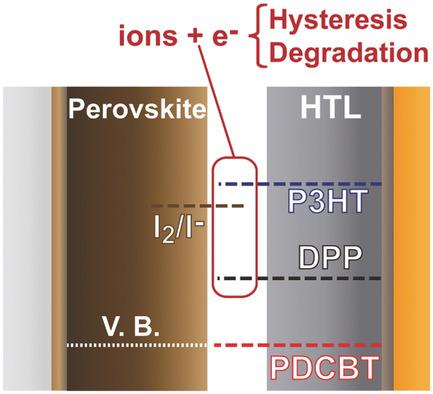当前位置:
X-MOL 学术
›
Adv. Energy Mater.
›
论文详情
Our official English website, www.x-mol.net, welcomes your
feedback! (Note: you will need to create a separate account there.)
Switching Off Hysteresis in Perovskite Solar Cells by Fine‐Tuning Energy Levels of Extraction Layers
Advanced Energy Materials ( IF 24.4 ) Pub Date : 2018-04-23 , DOI: 10.1002/aenm.201703376 Antonio Guerrero 1 , Agustín Bou 1 , Gebhard Matt 2 , Osbel Almora 2 , Thomas Heumüller 2 , Germà Garcia-Belmonte 1 , Juan Bisquert 1 , Yi Hou 2 , Christoph Brabec 2, 3
Advanced Energy Materials ( IF 24.4 ) Pub Date : 2018-04-23 , DOI: 10.1002/aenm.201703376 Antonio Guerrero 1 , Agustín Bou 1 , Gebhard Matt 2 , Osbel Almora 2 , Thomas Heumüller 2 , Germà Garcia-Belmonte 1 , Juan Bisquert 1 , Yi Hou 2 , Christoph Brabec 2, 3
Affiliation

|
Lead halide perovskites often suffer from a strong hysteretic behavior on their j–V response in photovoltaic devices that has been correlated with slow ion migration. The electron extraction layer has frequently been pointed to as the main culprit for the observed hysteretic behavior. In this work three hole transport layers are studied with well‐defined highest occupied molecular orbital (HOMO) levels and interestingly the hysteretic behavior is markedly different. Here it is shown that an adequate energy level alignment between the HOMO level of the extraction layer and the valence band of the perovskite, not only suppresses the hysteresis, avoiding charge accumulation at the interfaces, but also degradation of the hole transport layer is reduced. Numerical simulation suggests that formation of an injection barrier at the organic/perovskite heterointerface could be one mechanism causing hysteresis. The suppression of such barriers may require novel design rules for interface materials. Overall, this work highlights that both external contacts need to be carefully optimized in order to obtain hysteresis‐free perovskite devices.
中文翻译:

通过微调提取层的能级来关闭钙钛矿太阳能电池中的磁滞
卤化钙钛矿通常在其j - V上具有强烈的磁滞行为与缓慢的离子迁移有关的光电器件中的响应速度。电子提取层经常被认为是观察到的滞后行为的主要元凶。在这项工作中,研究了三个具有明确定义的最高占据分子轨道(HOMO)水平的空穴传输层,有趣的是,其磁滞行为显着不同。在此表明,提取层的HOMO能级与钙钛矿的价带之间的足够的能级对准,不仅抑制了磁滞现象,避免了电荷在界面处的积累,而且还减少了空穴传输层的劣化。数值模拟表明,在有机/钙钛矿异质界面处形成注入势垒可能是引起磁滞现象的一种机制。抑制这种壁垒可能需要新的界面材料设计规则。总的来说,这项工作强调必须仔细优化两个外部触点,以获得无磁滞的钙钛矿设备。
更新日期:2018-04-23
中文翻译:

通过微调提取层的能级来关闭钙钛矿太阳能电池中的磁滞
卤化钙钛矿通常在其j - V上具有强烈的磁滞行为与缓慢的离子迁移有关的光电器件中的响应速度。电子提取层经常被认为是观察到的滞后行为的主要元凶。在这项工作中,研究了三个具有明确定义的最高占据分子轨道(HOMO)水平的空穴传输层,有趣的是,其磁滞行为显着不同。在此表明,提取层的HOMO能级与钙钛矿的价带之间的足够的能级对准,不仅抑制了磁滞现象,避免了电荷在界面处的积累,而且还减少了空穴传输层的劣化。数值模拟表明,在有机/钙钛矿异质界面处形成注入势垒可能是引起磁滞现象的一种机制。抑制这种壁垒可能需要新的界面材料设计规则。总的来说,这项工作强调必须仔细优化两个外部触点,以获得无磁滞的钙钛矿设备。









































 京公网安备 11010802027423号
京公网安备 11010802027423号